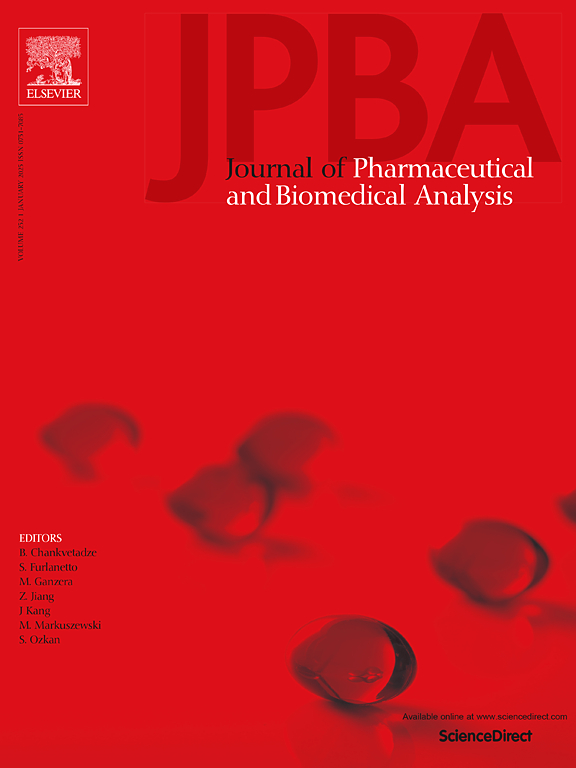A sensitive method for the profiling of phenyl- and indole-containing metabolites in blood serum and cerebrospinal fluid samples of patients with severe brain damage using ultra-high-pressure liquid chromatography-tandem mass spectrometry
IF 3.1
3区 医学
Q2 CHEMISTRY, ANALYTICAL
Journal of pharmaceutical and biomedical analysis
Pub Date : 2025-03-08
DOI:10.1016/j.jpba.2025.116803
引用次数: 0
Abstract
The metabolic profiling of biological fluids is important in understanding the various biochemical processes in the human body. The content of aromatic metabolites, including microbial ones, in the blood and cerebrospinal fluid, can provide essential information reflecting infectious processes, both systemic and in the central nervous system. A sensitive method with protein precipitation and sample concentration using ultra-high-pressure liquid chromatography-tandem mass spectrometry was proposed and subsequently validated to determine the number of aromatic metabolites of phenylalanine, tyrosine, and tryptophan in the blood serum and cerebrospinal fluid at 2.0–3.7 × 103 nmol/L. Reference values of 4-hydroxybenzoic, 3-(4-hydroxyphenyl)propionic, and indole-3-carboxylic acids were measured in the blood serum of healthy donors (n = 48). Profile of eleven phenyl- and indole-containing acids was revealed in the serum samples (n = 29) of the patients with long-term sequelae of severe brain damage and in the cerebrospinal fluid samples (n = 29) of the post-neurosurgical patients using different sample preparation methods to measure analytes in a wide (nmol/L and μmol/L) concentration range. Statistically significant differences in concentrations of most analytes were detected in serum samples of patients compared to healthy donors (p ≤ 0.03) and in concentrations of 3-phenyllactic, 3-(4-hydroxyphenyl)lactic, indole-3-lactic, and indole-3-carboxylic acids in cerebrospinal fluid samples of patients with signs of secondary bacterial meningitis compared to those without signs of secondary bacterial meningitis (p ≤ 0.027).
求助全文
约1分钟内获得全文
求助全文
来源期刊
CiteScore
6.70
自引率
5.90%
发文量
588
审稿时长
37 days
期刊介绍:
This journal is an international medium directed towards the needs of academic, clinical, government and industrial analysis by publishing original research reports and critical reviews on pharmaceutical and biomedical analysis. It covers the interdisciplinary aspects of analysis in the pharmaceutical, biomedical and clinical sciences, including developments in analytical methodology, instrumentation, computation and interpretation. Submissions on novel applications focusing on drug purity and stability studies, pharmacokinetics, therapeutic monitoring, metabolic profiling; drug-related aspects of analytical biochemistry and forensic toxicology; quality assurance in the pharmaceutical industry are also welcome.
Studies from areas of well established and poorly selective methods, such as UV-VIS spectrophotometry (including derivative and multi-wavelength measurements), basic electroanalytical (potentiometric, polarographic and voltammetric) methods, fluorimetry, flow-injection analysis, etc. are accepted for publication in exceptional cases only, if a unique and substantial advantage over presently known systems is demonstrated. The same applies to the assay of simple drug formulations by any kind of methods and the determination of drugs in biological samples based merely on spiked samples. Drug purity/stability studies should contain information on the structure elucidation of the impurities/degradants.

 求助内容:
求助内容: 应助结果提醒方式:
应助结果提醒方式:


